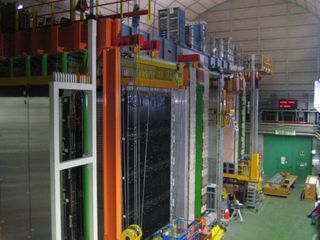Neutrinos faster than light?
 A team of particle physicists working at CERN have shaken the world of phyiscs by announcing that the neutrinos they have been firing towards Italy have travelled faster than light. More specifically, they have spent the last three years generating beams of neutrinos at a facility in Geneva, and firing them at the OPERA detector buried deep within Gran Sasso, a mountain in central Italy some 730km away. The ghostly nature of neutrinos made it possible to avoid the difficulties of getting around the curvature of the Earth by simply firing straight through the crust – a bit over 700km of solid rock. Both the distance travelled and the time taken were measured with extreme precision, resulting in a breathtaking conclusion: The neutrinos, on average, reached the target some 60ns (one nanosecond equals one billionth of a second) sooner than a beam of light would have. Assuming they’ve not made any mistakes, their neutrinos were travelling very slightly faster than light!
A team of particle physicists working at CERN have shaken the world of phyiscs by announcing that the neutrinos they have been firing towards Italy have travelled faster than light. More specifically, they have spent the last three years generating beams of neutrinos at a facility in Geneva, and firing them at the OPERA detector buried deep within Gran Sasso, a mountain in central Italy some 730km away. The ghostly nature of neutrinos made it possible to avoid the difficulties of getting around the curvature of the Earth by simply firing straight through the crust – a bit over 700km of solid rock. Both the distance travelled and the time taken were measured with extreme precision, resulting in a breathtaking conclusion: The neutrinos, on average, reached the target some 60ns (one nanosecond equals one billionth of a second) sooner than a beam of light would have. Assuming they’ve not made any mistakes, their neutrinos were travelling very slightly faster than light!This is incredible news. The speed of light is a constant, and marks not just the fastest speed anything has ever travelled, but the fastest speed that can exist. If this turns out to be false, then they will have shown us the first cracks in Einstein’s Special Theory of Relativity, which has withstood over 80 years of aggressive testing by ambitious physicists around the world. It’s a significant discovery, which is why we must be very very careful about making sure its right.
There are some issues that we must think about. The speeds involved are so high that the measurements involved need to be very, very precise. Light travels at about three hundred million meters per second, which equates to 30 centimeters each nanosecond. In sixty nanoseconds, therefore, it will travel 18 meters. Measuring large distances across the Earth’s surface to such precision is very hard, and there’s the additional complication of the size of the lab equipment – the detector alone is many meters across, and sophisticated statistical methods are needed to average out the distances travelled by individual neutrinos. If any mistakes have been made here, this will more than account for the difference.
Then there’s existing information about neutrinos. Scientists have been detecting them for years, from the Sun and deep space. For the last few decades, every nearby supernova is reliably accompanied by a storm of neutrinos. But “nearby” is a relative term. The closest supernova since we first began searching for neutrinos was in 1987 and was visible to the naked eye for about a month. It was 160,000 light years away. If neutrinos regularly travel at the speeds measured by this experiment, then we should have detected a neutrino burst four years before the supernova appeared in our skies. Instead, the neutrinos arrived at the same time as the light.
Now it’s important to realise that nothing I’ve said so far proves the results of the experiment to be false. Perhaps there’s something different about the neutrinos – we know that they come in different types, and have different energies. And perhaps my concerns about measurement errors aren’t valid – there is a lot in the paper about how they approached those problems which went over my head. This could be real!
But if it is, it does NOT mean that Einstein was wrong, anymore than Einstein proved Newton wrong. Newton’s laws of gravity are now known to only be approximations of how the universe actually works, and as we get to extreme conditions of mass or velocity, they start giving the wrong answers. But most of the time they’re accurate enough that we can use them. When NASA do the sums to aim a space probe billions of kilometers across the Solar System, steering through the Sun’s and Planets’s gravity fields, they use Newtons laws, not Einsteins! Similarly, Einstein’s equations give results that match what we see in real life extremely closely. This experiment doesn’t suddenly make all the sums work out differently, and it doesn’t stop technology that relies on them (GPS, fibre optics, DVD players to name a VERY small sample) from working.
But it might have opened the door to a whole new area of physics that we didn’t know existed. It creates a whole new arena for physicists to explore and work out, and brings us that much closer to understanding the universe. And I think that’s pretty cool!
